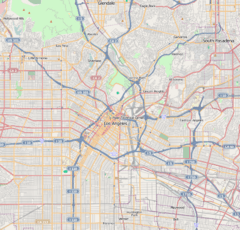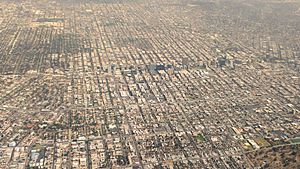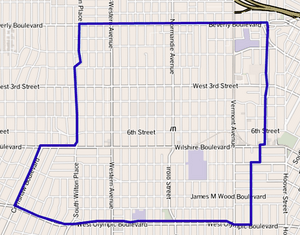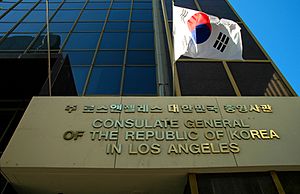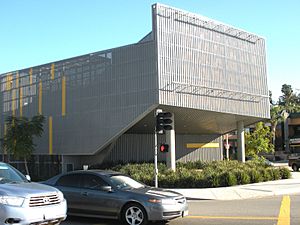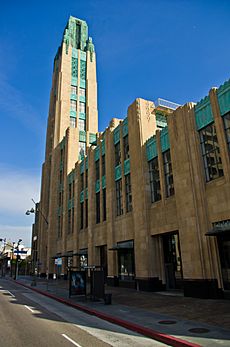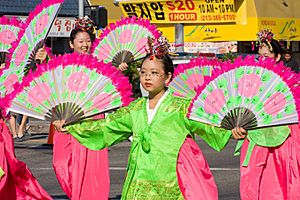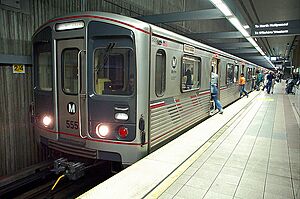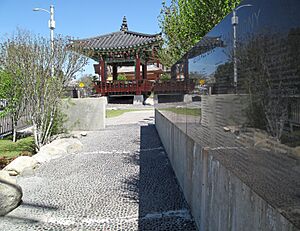Koreatown, Los Angeles facts for kids
Quick facts for kids
Koreatown
|
|
|---|---|
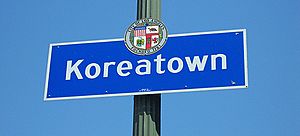
City of Los Angeles Koreatown marker
|
|
| Nickname(s):
"K-Town"
|
|
| Country | United States |
| State | California |
| County | Los Angeles |
| City | Los Angeles |
| Area
(about 150 blocks)
|
|
| • Total | 2.7 sq mi (7 km2) |
| Population
(2008)
|
|
| • Total | 124,281 |
| • Density | 46,208/sq mi (17,841/km2) |
| Population changes significantly depending on areas included and recent growth. | |
| ZIP Code |
90010, 90005, 90006
|
| Area code(s) | 213, 323 |
Koreatown (Korean: 코리아타운, Koriataun) is a lively neighborhood in central Los Angeles, California. It is often called "K-Town" by locals. This area is a major center for Korean culture and businesses in the United States.
Koreans started moving to Los Angeles in larger numbers in the 1960s. They found homes and opened businesses in the Mid-Wilshire area. Many old buildings with beautiful Art Deco designs were saved. This happened because new businesses moved in and kept them active.
Even though it's called Koreatown, it's a very diverse place. About half of the people living here are Latino, and one-third are Asian. Many residents, about two-thirds, were born outside the United States. This makes Koreatown a unique and interesting mix of cultures.
History of Koreatown
Early Korean Settlers (1900s–1980s)
In 1882, the United States and Korea signed a treaty. This treaty allowed Koreans to travel to the U.S. Many Koreans first came to Hawaii in the late 1800s. By the early 1900s, some Korean immigrants moved to Los Angeles. They formed communities around churches.
As more Koreans arrived, their homes and businesses spread. They settled near the Los Angeles business district. By the 1930s, about 650 Koreans lived in Los Angeles. They opened restaurants and community groups. They also started businesses, mainly selling fruits and vegetables.
In 1936, the Korean National Association moved its main office to Los Angeles. This group helped promote Korean culture and education. However, old laws called racial covenant laws limited where Koreans could live. They were mostly in low-income areas.
After 1948, these unfair housing laws were stopped. Koreans then began to move north of Olympic Boulevard. They built new homes and businesses there.
In the late 1960s, the area around Koreatown started to decline. Many buildings became empty. This attracted wealthier immigrants from South Korea. They found cheap housing and opened businesses. This helped save many of the old Art Deco buildings. A new law in 1965 also allowed more Asian people to move to the U.S. This helped Koreatown grow even more.
By the late 1970s, most businesses on Olympic Boulevard were owned by Koreans. This growth led to Korean newspapers and community groups. These groups helped create a strong community feeling. In 1982, residents successfully asked for the first Koreatown sign to be put up.
Community Challenges and Growth (1992–Present)
In 1992, Los Angeles experienced major unrest. This event affected Koreatown greatly. Many Korean-owned businesses were damaged or destroyed. About $50 million in damage occurred, with half of it affecting Korean businesses.
During this time, roads leading out of Koreatown were blocked. Some Korean Americans felt trapped and without help. This event led to more community groups forming. Organizations like the Koreatown Youth and Community Center (KYCC) helped Korean Americans. They worked to get support from the government.
Since the 2000s, Koreatown has continued to grow. In 2008, Los Angeles made Koreatown a special "graphics district." This allows for large digital signs and billboards. It makes the area look like famous places such as Times Square in New York.
New metro stations and shopping centers have also opened. Koreatown is now known for its many restaurants and businesses that are open 24 hours. It has become a popular place for tourists.
Koreatown is unique because of its diverse population. Many Latino employees in restaurants speak Korean with customers. Korean business owners often speak Spanish with Latino customers. You can even find Korean-inspired taco trucks here. They mix classic Mexican food with Korean ingredients!
Koreatown's Location and Boundaries
Koreatown is about 3 miles (5 km) west of downtown Los Angeles. It is generally a flat area.
The exact borders of Koreatown can be a bit confusing. The main street is Wilshire Boulevard. But the area also stretches south to Olympic Boulevard and north to Beverly Boulevard. It even spills into nearby neighborhoods.
How Koreatown's Borders Changed
In the early 1900s, Koreans lived mostly around the downtown Bunker Hill area. This was due to old laws that limited where different groups could live. By the 1930s, Koreans started moving to Jefferson Boulevard.
A big change happened in the 1960s. More people moved out of the mid-Wilshire area. This allowed Asian residents to move in. The area north of Olympic Boulevard became a main home for the Korean American community. In 1980, Los Angeles officially named the neighborhood "Koreatown."
Official City Boundaries
The City of Los Angeles has official boundaries for Koreatown. These are:
- East: Vermont Avenue
- West: Western Avenue
- North: Third Street
- South: Olympic Boulevard
There is also a business area along Western Avenue that is part of Koreatown.
Mapping Koreatown
Different maps show slightly different boundaries for Koreatown. For example, Google Maps uses the same borders as the city. The Los Angeles Times Mapping L.A. project shows a larger area. This larger area includes neighborhoods like Wilshire Center.
Koreatown's Climate
| Climate data for Koreatown, Los Angeles | |||||||||||||
|---|---|---|---|---|---|---|---|---|---|---|---|---|---|
| Month | Jan | Feb | Mar | Apr | May | Jun | Jul | Aug | Sep | Oct | Nov | Dec | Year |
| Mean daily maximum °F (°C) | 68 (20) |
69 (21) |
70 (21) |
73 (23) |
75 (24) |
80 (27) |
84 (29) |
85 (29) |
84 (29) |
79 (26) |
73 (23) |
69 (21) |
76 (24) |
| Mean daily minimum °F (°C) | 47 (8) |
49 (9) |
50 (10) |
53 (12) |
57 (14) |
60 (16) |
64 (18) |
65 (18) |
63 (17) |
58 (14) |
51 (11) |
47 (8) |
55 (13) |
| Average precipitation inches (mm) | 3.39 (86) |
3.72 (94) |
3.14 (80) |
0.82 (21) |
0.29 (7.4) |
0.06 (1.5) |
0.02 (0.51) |
0.14 (3.6) |
0.32 (8.1) |
0.39 (9.9) |
1.12 (28) |
1.93 (49) |
15.34 (390) |
People of Koreatown (Demographics)
Koreatown is one of the most crowded neighborhoods in the United States. In 2000, about 115,070 people lived in this 2.7-square-mile area. This means there were about 42,611 people per square mile. By 2008, the population grew to 124,281. The average age of residents is 30.
Koreatown has many different ethnic groups. About 53.5% of residents are Latino. About 32.2% are Asian. The rest are white, black, or other groups. A large number of residents, 68%, were born outside the U.S. The most common birthplaces are Korea (28.6%) and Mexico (23.9%).
The average household income in 2008 was $30,558. This is lower than the average for Los Angeles. Most people (93%) rent their homes in Koreatown.
Koreatown's Economy
Olympic Boulevard in Koreatown is full of Korean signs and new shopping centers. This business area has grown a lot. It now stretches along Olympic Boulevard, Vermont Avenue, 8th Street, and Western Avenue.
South Korea has invested a lot of money in Koreatown since the 1960s. This investment has grown even more since the early 2000s. It is now estimated to be about $1 billion in new buildings. Jamison Services, Inc. is the biggest landlord and builder in Koreatown.
The area also has a fun nightlife. There are many lively restaurants and clubs. Korean barbeque restaurants and karaoke bars are very popular.
Several international airlines have offices in Koreatown. Asiana Airlines has a sales office. Korean Air's U.S. headquarters are nearby. Many countries also have their consulates (offices that help their citizens) in Koreatown. These include South Korea, China, El Salvador, Guatemala, Honduras, Nicaragua, Bolivia, Indonesia, and the Philippines.
Education in Koreatown
About 21.4% of adults in Koreatown have a four-year college degree. This is about average for Los Angeles. However, many residents have less than a high school diploma.
Here are some of the schools in Koreatown:
- Central City Value, a high school
- Ambassador School of Global Leadership, a K-12 school
- New Open World Academy, a K-12 school
- UCLA Community School, a K-12 school
- Virgil Middle School
- Young Oak Kim Academy
- Cahuenga Elementary School
- Saint Brendan School, a private elementary school
- New Horizon School/Los Angeles, a private elementary school
- Saint James' Episcopal Day School, a private elementary school
- Camino Nuevo Charter Academy
- Saint Gregory Nazianzen, a private elementary school
- Wilton Place Elementary School
- Hobart Boulevard Elementary School
- Mariposa-Nabi Primary Center
- Pilgrim School, a private preK-12 school
- Larchmont Charter School - Layfayette Park Campus (grades 8-12)
- Berendo Middle School
- Los Angeles Senior High
Other Learning Centers
The Korean Education Center is in Koreatown. It is connected to the government of South Korea. Southwestern Law School also offers programs here.
Public Libraries
The Pio Pico Koreatown Branch Library serves the area. It is part of the Los Angeles Public Library system.
Fun in Koreatown: Festivals and Community
Koreatown hosts several annual festivals.
- The Korean Festival & Parade takes place on Olympic Boulevard. It includes a march to the Seoul Peace Park.
- The Wilshire Center Business Improvement District holds an Earth Day / Car Free Day Festival every April 22.
- KTOWN Night Market has an annual festival at Robert F. Kennedy Community Schools.
Community Organizations
- The Anderson-Munger YMCA offers swimming, exercise, and programs for kids and teens.
- Koreatown Immigrant Workers Alliance (KIWA) works for social change in the community.
Getting Around Koreatown (Transportation)
The Los Angeles County Metropolitan Transportation Authority (Metro) has two subway lines in Koreatown.
- The B Line runs under Vermont Avenue.
- The D Line runs under Wilshire Boulevard.
Koreatown has three D Line stations: Wilshire/Normandie, Wilshire/Vermont, and Wilshire/Western.
Metro also runs many bus lines in the area. These include Express, Rapid, and Local buses. Many Metro bus lines in Koreatown run 24 hours a day.
The LADOT (Los Angeles Department of Transportation) also operates DASH routes. These are shorter bus routes for getting around the neighborhood. DASH Hollywood/Wilshire and DASH Koreatown serve the area. DASH fares are 50 cents.
Notable Places in Koreatown
- The Korean American National Museum - 3727 West 6th Street
- The Korean Cultural Center - 5505 Wilshire Boulevard
- Korean Pavilion and parklet, Normandie Avenue just north of Olympic Boulevard
- Koreatown Plaza - 928 South Western Avenue
- Chapman Park Market, 3405 West 6th Street
- The Wiltern Theater at Wilshire Boulevard and Western Avenue.
- Liberty Park - 3700 Wilshire Boulevard
- LA Metro subway station, Western Avenue and Wilshire Boulevard.
- Bimini Baths
- Cafe Brass Monkey
Images for kids
See also
 In Spanish: Koreatown (Los Ángeles) para niños
In Spanish: Koreatown (Los Ángeles) para niños


